
 |
Kayak Design Terms & Hydrostaticsdefinitions of form coefficients, volumetric and waterplane properties |
|
For many people, kayak selection rarely goes beyond the visual appeal of
'the shape'. Aesthetics are critical as the 'first impression' but hydrostatics
and form coefficients allow a deeper understanding of the hull as a physical
body interacting with a fluid. Many of these coefficients are also instrumental for more objective comparison of different types of kayak hull forms. Like a piece of puzzle, any one coefficient by itself is not enough to make a judgment but taken as a whole, the entire kayak and its performance potential begins to crystallize. The terms below are but a few useful measurements that go into the kayak design 'recipe'. All the terms here are used in the 'Technical Specifications' of One Ocean Kayak designs. |
||
| . |  |
|
| . top |  The 'horizontal' difference between the BOA and the BWL is also referred to as 'flare'. A large flare rapidly changes the position of the TCB (transversal center of buoyancy) of the kayak when leaned to the side. The TCB moves farther sideways or 'outboard', underneath the paddler's TCG (transversal center of gravity) thus providing support and resistance to capsize. This is called "secondary" or "reserve" buoyancy. A good analogy is the example of a trimaran outrigger. The farther the outrigger (buoyant volume) is from the main hull, the more resistant the craft becomes to the 'heeling moment' or force of the sail that would keel it over. That is also a main reason why sailboats are relatively 'wide' and feature large hull flare. |
|
| . top | 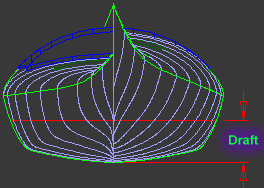 Draft is measured from baseline to the designed waterline. It is the amount that the kayak is submerged in the water. |
|
| . top | 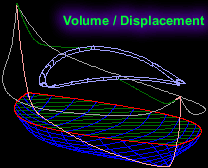 The "Volume" indicates the volume of sea water (ft^3) the kayak displaces at the designed displacement (lb). Note that sea water is denser than fresh water so even though the kayak has the same displacement (kg or lb), the volume displaced will be slightly higher in fresh water. This means that the kayak will be submerged more in fresh water. In practical terms, this is of no consequence. Let's say the volume displaced is 4 ft^3 so the difference is about 6.8lb between fresh water and sea water displacement. This translates to about 1/8" (2mm) difference in draft. Salt water is used for all calculations. Sea water density - 1025,9 kg/m^3 or 64 lb/ft^3 Fresh water density - 1000 kg/m^3 or 62.3 lb/ft^3 |
|
| . top |  LCB is the distance from the start of the waterline to the center of the volume the kayak displaces. The center of the displaced volume is called a 'centroid' but LCB is just the x direction component of its coordinates. The others are VCB - vertical center of buoyancy and TCB - transverse center of buoyancy. The center of buoyancy as an imaginary focus of all vertical forces that keep the kayak afloat. Its counterpart, the LCG, is the focus of all loads that push the kayak down. Under normal conditions and In the absence of other forces LCB and LCG are in balance or equilibrium. The %LCB is the longitudinal location of the LCB with respect to the waterline. %LCB is what often distinguishes whether a kayak is 'Fish' or 'Swede' form. Fish form kayaks have LCB less than 50% of LWL while Swede hull forms are more than 50%. Swede hullforms displace water more efficiently, reducing the effect of wave resistance and are therefore faster, especially at higher cruising and racing speeds. Smaller pitching motion in waves, good handling in following seas (waves coming from the back) and drier ride are few other benefits of Swede hull forms. All One Ocean Kayak designs are Swede hull forms. LCB in sea kayaks ranges from 49% for 'Fish forms' up to 55% for 'Swede forms'. Designs beyond these limits result in poor directional stability as in the Swede forms or lack of maneuverability as in the Fish forms. |
|
| . top |  Vertical center of buoyancy (VCB) is the vertical coordinate of the displaced volume centroid. Hard chine and flat bottom boats have lower VCB than rounder or elliptical hulls. Higher VCB has positive effects on secondary stability. |
|
| . top |  Waterplane area is the horizontal patch of surface that is formed by the intersection of the kayak hull at the designed waterline (or Draft) with the surface of the water. The Waterplane has an affect on wave resistance, stability and pitching in waves. LCF is the longitudinal coordinate of the Waterplane Centroid from the start of the waterline. %LCF is the longitudinal location of the Waterplane centriod with respect to the length of the waterline. The axis of the pitching motions (rocking back and forth) in a boat mostly coincides with the LCF. In general, the larger the %LCF the smaller the amplitude of pitching. |
| . top | 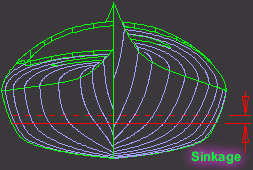 Sinkage measures the distance a kayak sinks for a given load on top of the 'displacement'. This is very useful to know when loading kayak with gear. It suggests the amount of loading before the kayak's performance is noticeably degraded. This measurement is not linear. This means that the sinkage for a given kayak may be 92lb/inch, but it may be only 38lb per 0.5inch but 220lb per 2 inches. |
| . top |  Unlike the prismatic coefficient, Cb is not constrained by the crossectional shape of the hull so it measures the fullness of the entire displaced volume rather than the 'tips' alone. If the hull filled the entire block defined by LWL x BWL x Draft, the Cb would equal 1. Both the Cm and Cp are related to the Block coefficient in the following relationship CB=Cp x Cm. Large block coefficient makes for 'squat' hulls with poor directional stability. |
| . top | 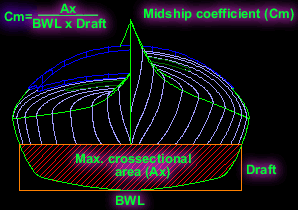 Midship coefficient is defined as the ratio of the maximum sectional area of the hull divided by the rectangular area formed by the waterline beam and draft. The larger the Cm the more rectangular and hard chined the sections. Note, that water must bypass this shape as the kayak plows its way through it and a large Cm implies more drag. Cm is a large factor in determining the shape of the hull as well as the surface area. The compromise here is between the largest Ax with the smallest perimeter and the stability of the craft. An efficient crossectional shape would have to be elliptical but this is not always desirable if a hull must perform well in ways other than pure speed. Needless to say, its all carefully balanced compromise. |
| . top | 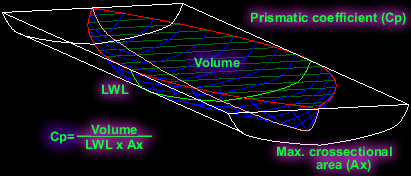 Prismatic coefficient determines the 'fatness' or 'fineness' of the hulls ends. It is the ratio of the 'displaced volume' divided by a block, the volume of which equals the length of the waterline multiplied by the hull's maximum crossectional area. The slimmer the tips of the kayak the less volume of the block the hull occupies and the smaller the Prismatic coefficient. Conversely, imagine a boat such as a barge or pontoon that would fill the entire volume of the block. In this instance the Cp would be equal to 1. Prismatic coefficient is one of the more important factors used in determining the general shape of the hull for a given performance envelope. There is a direct correlation between Prismatic coefficient, hull speed and waterline length as relates to wave resistance. Cp is incorporated into most 'Hull performance' prediction algorithms and is also used by hull designers to shape their boats for optimal performance within the desired speed range. Cp's for kayaks range from 0.45 for lower speed hulls up to 0.65 for racing kayaks. |
| . top |  Like the Cm, the Waterplane coefficient expresses the fullness of the waterplane. Full waterplane is an essential ingredient in a seaworthy kayak design. It improves secondary stability as well as handling behavior of the kayak in rough conditions. |
| . top |  Area / Displacement Ratio This ratio is one of the true measurements of the wetted surface area as it relates to the displaced volume it contains. For example, kayak X that has a low A/D ratio can take a bigger load or fit a heavier paddler than kayak Y, even though both have the same wetted surface. Since both kayaks will have the same viscous resistance, kayak X will be more efficient because it is not penalized by the extra weight. This ratio is useful only in conjunction with other hydrostatic indicators. For example, a sphere which has the lowest A / D ratio of all solid objects, would hardly make a suitable craft. Kayak A/D ratios range from 8.1 for fast round hulls to about 9.4 for hard chined, flat bottom 'dragsters'. The ratio has no units because they cancel out. |
| . top | Length / Beam Ratio This ratio is the LWL divided by BWL and is a generally good predictor of kayak performance. The range goes from about 5 for very short recreational kayaks to more than 14 for high performance sprint kayaks. The higher the ratio the higher the potential speed because of reduced wave resistance. |
| . top | 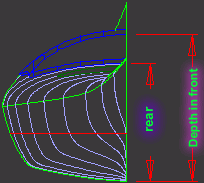
Both the front and rear depth measurements of the cockpit are essential for proper matching of the kayak to the size and paddling style of the kayaker. The measurements apply to the usable inside cockpit. |
| Home | Kayak Designs | Kayak Shop | Materials | Kayak Gallery | About us |
| Building Manual | Plans | Sandwich Core | Wood Kayak | Order | |
| Epoxy Test | Abrasion Cloth | Rudder | Resources | Choosing Kayak | Guestbook |
If you notice any problems with the site (i.e. error links, missing images) please, let me know. Thanks
Mail:
Vaclav Stejskal
58 Wood Ln.
Acton, MA 01720
USA
Tel: 781-481-9261
© 1999
- 2024 Copyright Vaclav Stejskal
All rights reserved
Last page update:
9 May 2024